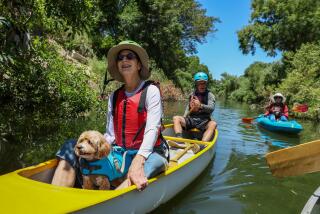Turning Back the Tide
- Share via
An electric current strong enough to zap out AM-radio channels in passing cars flows through the air, booms from giant hammer machines pound out the roar of the ocean, a chemical odor hits the nostrils, and dust blows off a slag heap from a nearby aluminum recycling plant.
Add thunder from military jets, graffiti, burned out campfires, rusty car parts stuck in the sand, broken glass and litter--and a picture of Oxnard’s Ormond Beach as it looks today begins to emerge.
It might sound like a place most people would avoid, but Cal Lutheran University professor Jan Bowman is not one of them. In the degraded beach, with an electrical power plant at one end, Bowman sees a perfect field laboratory: a place where students will help rehabilitate a squalid area, creating an environment where people and endangered species can live together.
And in the site itself--sandwiched between Port Hueneme and Point Mugu Naval Air Station--she sees a laboratory of ideas, from which professors and students from many disciplines can explore a range of academic pursuits, such as marine biology, English literature and environmental ethics.
It was during a trip to Maine last summer that Bowman heard about a group of volunteers who had restored a beach on the Eastern Seaboard. That got her thinking about just such a project for Ventura County.
“I was so inspired by how hundreds of volunteers in Maine had made it possible for an estuary, a marine life nursery, to replenish itself so that birds and vegetation could return,” Bowman said.
When she returned to Thousand Oaks, where she has taught English for 25 years, she began making phone calls and discovered that a beach close by needed attention. Ormond Beach has several owners--including Southern California Edison, the city of Oxnard, and several private industries.
“I learned that Ormond Beach was in a state of severe degradation, with very little activity in its estuaries because of pollution,” Bowman said.
Although it is hard to look past the pollution, she said, Bowman sees a lot of potential when she does, including a great view of the Channel Islands.
Since last summer, she has gotten students and faculty members from a range of academic fields involved in her crusade to improve the area, which in turn has enriched the school’s curriculum. The English department now offers a course in literature of the Earth, and the religion department offers environmental ethics. Geology offers an ocean class, biology an environmental ecology class, and the marine biology department an ecology and evolution class.
“Ormond Beach is exactly what a laboratory should be, since it represents a microcosm of what is going on all over the country,” said Bowman, who believes the reclamation could take years.
When marine biology professor Andrea Huvard added Ormond Beach to the school’s list of outdoor field labs, she contacted U.S. Fish and Wildlife Service biologist David Pritchett. She found out what research the Department of Interior agency needed done to provide students with work experience to complement their academic studies.
Huvard said it might be possible to enlist the cooperation of neighboring industries in getting Ormond Beach restored. Significant grant money could be available as well as opportunities for fund-raising in the community, but it would be a major undertaking, she said.
So far, her students have been collecting data and doing scientific studies to assist Pritchett in finding ways to preserve what he described as one of the few remaining natural wildlife wetlands in Southern California.
“Ormond Beach is the habitat for several endangered species of plants and animals,” Pritchett said.
Among them are dozens of California least terns who nest in the sand. Nonnative and invasive ice plants growing on the dunes have threatened their habitats, so the plants were recently removed by Cal Lutheran student volunteers during a service day.
Businesses are considering developing parts of the two-mile beach. Someday it could include a desalination plant that turns salt water into fresh water. Residential and recreational facilities are also under consideration, Pritchett said.
Whatever happens to the beach and around the beach, all of it is fodder for academic thought.
In the environmental ethics class, where religion students look at Earth and people as sacred creations from God, land development in the Ormond Beach area is one of the many issues debated.
“We look at Ormond Beach and think about ethical questions--should land be preserved for birds and plants? Are they more important than people?” said religion teacher Byron Swanson.
And ethics, geology and marine biology students study the effect that crops--delicious-looking citrus and strawberries that line the roads to the beach--have on the environment.
While one set of students may ultimately castigate businesses for causing pollution that degrades the environment, another set may laud industry for keeping people from turning the area into another Malibu.
The industry surrounding the beach hid it from Cal Lutheran University freshman Michael Divindo, 18, who was born in Port Hueneme and grew up in Oxnard.
“I never came here before,” said Divindo during the university’s service day. “I didn’t know this beach existed. I went to other beaches, but I never thought about this place.”
More to Read
Sign up for Essential California
The most important California stories and recommendations in your inbox every morning.
You may occasionally receive promotional content from the Los Angeles Times.










